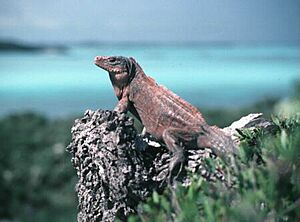Acklins ground iguana facts for kids
Quick facts for kids Acklins ground iguana |
|
|---|---|
 |
|
| Scientific classification |
|
| Kingdom: | Animalia |
| Phylum: | Chordata |
| Class: | Reptilia |
| Order: | Squamata |
| Suborder: | Iguania |
| Family: | Iguanidae |
| Genus: | Cyclura |
| Species: | |
| Subspecies: |
C. r. nuchalis
|
| Trinomial name | |
| Cyclura rileyi nuchalis Barbour and Noble, 1916
|
|
The Acklins ground iguana (Cyclura rileyi nuchalis) is a special type of lizard. It is also known as the Watling Island iguana. This iguana is an endangered animal. It is one of three types of Cyclura rileyi iguanas. These lizards belong to the Iguanidae family.
Contents
What is the Acklins Ground Iguana?
The Acklins ground iguana is a recognized subspecies. It is a type of San Salvador rock iguana. Scientists have known it as a subspecies since 1975. Its scientific name, rileyi, comes from an American biologist named Joseph Harvey Riley.
How Does the Acklins Ground Iguana Look?
This iguana looks a lot like the San Salvador rock iguana. It has similar colors and body shape.
Colors and Patterns
The iguana's back can be many colors. These include red, orange, yellow, green, brown, or grey. It often has darker patterns. The brightest colors, like red and orange, are usually seen on males. These colors get even brighter when the iguana is warm. Young iguanas do not have these bright colors. They are usually solid brown or grey with faint stripes.
Unique Features
What makes this iguana special are the scales on its neck and head. They are different from the other two subspecies.
Males and Females
Like other Cyclura iguanas, males and females look different. This is called sexual dimorphism. Males are bigger than females. They also have larger crests along their backs. Males have special pores on their thighs. These pores release chemicals called pheromones.
Where Do Acklins Ground Iguanas Live?
The Acklins ground iguana lives only in the Bahamas. It is found on three small islands called cays. This means it is endemic to these islands.
Natural Homes
You can find natural groups of these iguanas on Fish Cay and North Cay. These islands are in the Acklins Bight, Bahamas. They used to live on Long (Fortune) Cay too.
New Populations
In the 1970s, five iguanas were moved to another small cay. This started a new group there. Today, there are about 12,500 to 18,800 iguanas in these two main groups. Another group of about 300 iguanas lives in the Exumas Land and Sea Park. This group seems to be doing well.
What Do Acklins Ground Iguanas Eat?
Like all Cyclura species, the Acklins ground iguana mostly eats plants. This means they are herbivores.
Plant-Based Diet
About 95% of their diet comes from plants. They eat leaves, flowers, and fruits. They get their food from at least 7 different plant types. Some of these plants include seaside rock shrub (Rachicallis americana) and erect prickly pear (Opuntia stricta).
Rare Animal Food
Sometimes, they might eat small animals. One wild iguana was even seen eating mice. But this is very rare.
How Do Acklins Ground Iguanas Mate?
Mating for these iguanas happens between May and June. The exact time depends on when the dry season ends.
Laying Eggs
Females usually lay 2 to 5 eggs. They lay their eggs about 40 days after mating. The number of eggs depends on the female's size and age. Some females travel to sandy coastal areas to build their nests. They dig their nests in the sand. Some females will guard their nest for a short time after laying eggs.
Hatching Babies
The baby iguanas hatch from their nests in August or early September.
What is the Acklins Ground Iguana's Home Like?
Unlike other Cyclura species, the Acklins ground iguana is safe from wild animals like dogs. The islands where they live are far away. People do not bother them much.
Natural Safety
Some birds like ospreys, herons, kestrels, and seagulls hunt them. But these natural predators do not harm the overall iguana population much.
Food and Plants
The Acklins Cays have a lot of food and plants. This is more than on islands where other iguanas live. This also helps them survive.
Future Threats
The biggest threat to these iguanas in the future is rising sea levels. Their islands are very low. If the sea level rises by 1 meter in the next 100 years, they could lose up to half of their home.

